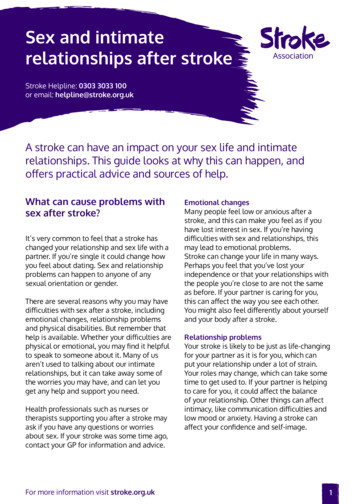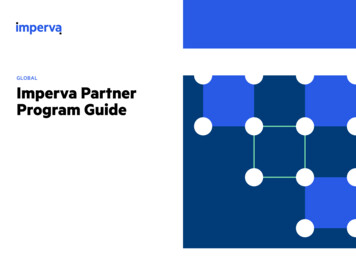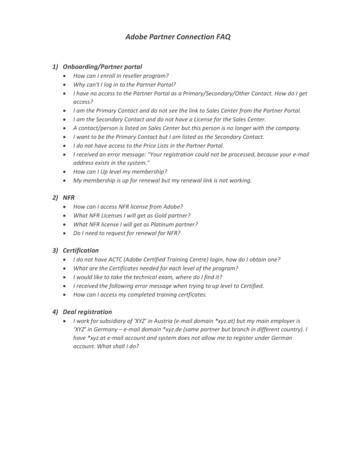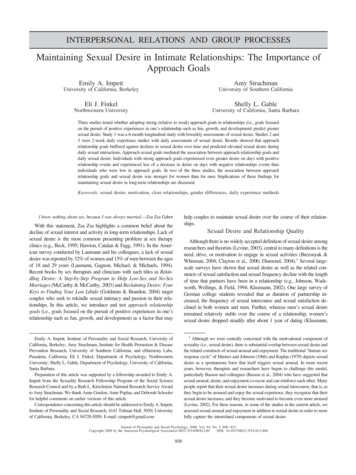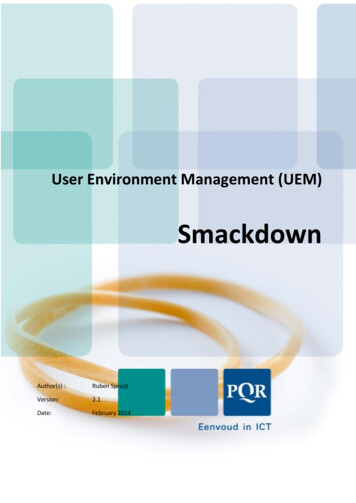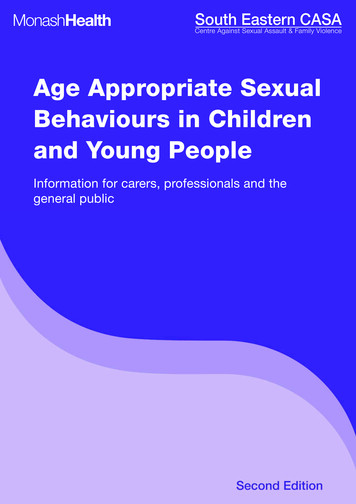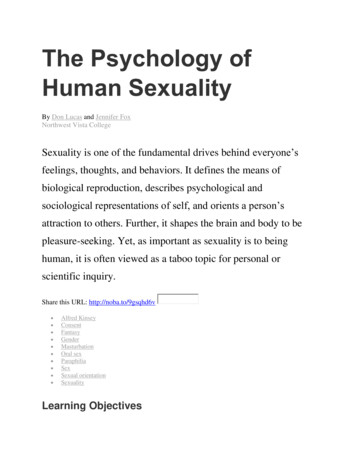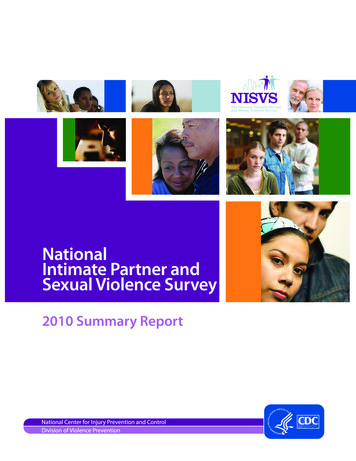
Transcription
NationalIntimate Partner andSexual Violence Survey2010 Summary Report
bThe National Intimate Partner and Sexual Violence Survey 2010 Summary ReportThe National Intimate Partner and Sexual Violence Survey: 2010 SummaryReport is a publication of the National Center for Injury Prevention andControl of the Centers for Disease Control and Prevention.Centers for Disease Control and PreventionThomas R. Frieden, MD, MPH, DirectorNational Center for Injury Prevention and ControlLinda C. Degutis, DrPH, MSN, DirectorDivision of Violence PreventionHoward R. Spivak, MD, DirectorSuggested Citation:Black, M.C., Basile, K.C., Breiding, M.J., Smith, S.G., Walters, M.L., Merrick, M.T.,Chen, J., & Stevens, M.R. (2011). The National Intimate Partner and SexualViolence Survey (NISVS): 2010 Summary Report. Atlanta, GA: National Centerfor Injury Prevention and Control, Centers for Disease Control and Prevention.
The National Intimate Partner and Sexual Violence Survey 2010 Summary ReportThe National Intimate Partnerand Sexual Violence Survey:2010 Summary ReportMichele C. Black, Kathleen C. Basile, Matthew J. Breiding, Sharon G. SmithMikel L. Walters, Melissa T. MerrickJieru Chen and Mark R. StevensNovember 2011National Center for Injury Prevention and ControlCenters for Disease Control and PreventionAtlanta, Georgiai
iiThe National Intimate Partner and Sexual Violence Survey 2010 Summary ReportTABLE OF CONTENTSList of Tables and Figures . . . . . . . . . . . . . . . . . . . . . . . . . . . . . . . . . . . . . . . . . . . . . . . . . . . . ivContributors . . . . . . . . . . . . . . . . . . . . . . . . . . . . . . . . . . . . . . . . . . . . . . . . . . . . . . . . . . . . . . . . viAcknowledgments. . . . . . . . . . . . . . . . . . . . . . . . . . . . . . . . . . . . . . . . . . . . . . . . . . . . . . . . . . viiDedication. . . . . . . . . . . . . . . . . . . . . . . . . . . . . . . . . . . . . . . . . . . . . . . . . . . . . . . . . . . . . . . . . viiiExecutive Summary. . . . . . . . . . . . . . . . . . . . . . . . . . . . . . . . . . . . . . . . . . . . . . . . . . . . . . . . . . 1Sections:1. Background and Methods. . . . . . . . . . . . . . . . . . . . . . . . . . . . . . . . . . . . . . . . . . . . . . . . . .5What is the National Intimate Partner and Sexual Violence Survey? . . . . . . . . . . . . . . . . . . . . . . . . . . . . . . . . . 7How was the survey developed?. . . . . . . . . . . . . . . . . . . . . . . . . . . . . . . . . . . . . . . . . . . . . . . . . . . . . . . . . . . . . . . . . . . 8What does this report include?. . . . . . . . . . . . . . . . . . . . . . . . . . . . . . . . . . . . . . . . . . . . . . . . . . . . . . . . . . . . . . . . . . . . 9Methods. . . . . . . . . . . . . . . . . . . . . . . . . . . . . . . . . . . . . . . . . . . . . . . . . . . . . . . . . . . . . . . . . . . . . . . . . . . . . . . . . . . . . . . . . . 9Survey instrument. . . . . . . . . . . . . . . . . . . . . . . . . . . . . . . . . . . . . . . . . . . . . . . . . . . . . . . . . . . . . . . . . . . . . . . . . . . . . . . . 9Survey administration. . . . . . . . . . . . . . . . . . . . . . . . . . . . . . . . . . . . . . . . . . . . . . . . . . . . . . . . . . . . . . . . . . . . . . . . . . . . 10Interviewer recruitment, training and monitoring. . . . . . . . . . . . . . . . . . . . . . . . . . . . . . . . . . . . . . . . . . . . . . . . . 11IRB and OMB Approval. . . . . . . . . . . . . . . . . . . . . . . . . . . . . . . . . . . . . . . . . . . . . . . . . . . . . . . . . . . . . . . . . . . . . . . . . . . 12Data analysis. . . . . . . . . . . . . . . . . . . . . . . . . . . . . . . . . . . . . . . . . . . . . . . . . . . . . . . . . . . . . . . . . . . . . . . . . . . . . . . . . . . . . 12Data quality assurance. . . . . . . . . . . . . . . . . . . . . . . . . . . . . . . . . . . . . . . . . . . . . . . . . . . . . . . . . . . . . . . . . . . . . . . . . . . 132. Sexual Violence Victimization. . . . . . . . . . . . . . . . . . . . . . . . . . . . . . . . . . . . . . . . . . . . . 15Prevalence of sexual violence victimization. . . . . . . . . . . . . . . . . . . . . . . . . . . . . . . . . . . . . . . . . . . . . . . . . . . . . . . 18Prevalence of rape and other sexual violence by race/ethnicity. . . . . . . . . . . . . . . . . . . . . . . . . . . . . . . . . . . . 20Type of perpetrator in lifetime reports of sexual violence. . . . . . . . . . . . . . . . . . . . . . . . . . . . . . . . . . . . . . . . . . 21Number of perpetrators in lifetime reports of sexual violence. . . . . . . . . . . . . . . . . . . . . . . . . . . . . . . . . . . . . . 23Sex of perpetrator in lifetime reports of sexual violence. . . . . . . . . . . . . . . . . . . . . . . . . . . . . . . . . . . . . . . . . . . 24Age at the time of first completed rape victimization. . . . . . . . . . . . . . . . . . . . . . . . . . . . . . . . . . . . . . . . . . . . . . 25Rape victimization as a minor and subsequent rape victimization . . . . . . . . . . . . . . . . . . . . . . . . . . . . . . . . . 263. Stalking Victimization. . . . . . . . . . . . . . . . . . . . . . . . . . . . . . . . . . . . . . . . . . . . . . . . . . . . 27Prevalence of stalking victimization . . . . . . . . . . . . . . . . . . . . . . . . . . . . . . . . . . . . . . . . . . . . . . . . . . . . . . . . . . . . . . 29Prevalence of stalking victimization by race/ethnicity. . . . . . . . . . . . . . . . . . . . . . . . . . . . . . . . . . . . . . . . . . . . . 31Tactics used in lifetime reports of stalking victimization. . . . . . . . . . . . . . . . . . . . . . . . . . . . . . . . . . . . . . . . . . . 31Type of perpetrator in lifetime reports of stalking victimization. . . . . . . . . . . . . . . . . . . . . . . . . . . . . . . . . . . . 32Number of perpetrators in lifetime reports of stalking victimization. . . . . . . . . . . . . . . . . . . . . . . . . . . . . . . .33Sex of perpetrator in lifetime reports of stalking victimization. . . . . . . . . . . . . . . . . . . . . . . . . . . . . . . . . . . . . 33Age at the time of first stalking victimization. . . . . . . . . . . . . . . . . . . . . . . . . . . . . . . . . . . . . . . . . . . . . . . . . . . . . . 34
The National Intimate Partner and Sexual Violence Survey 2010 Summary Report4. Violence by an Intimate Partner. . . . . . . . . . . . . . . . . . . . . . . . . . . . . . . . . . . . . . . . . . . 35Prevalence of rape, physical violence, and/or stalking. . . . . . . . . . . . . . . . . . . . . . . . . . . . . . . . . . . . . . . . . . . . . 39Prevalence of rape, physical violence, and/or stalking by race/ethnicity. . . . . . . . . . . . . . . . . . . . . . . . . . . . 39Overlap of rape, physical violence, and stalking. . . . . . . . . . . . . . . . . . . . . . . . . . . . . . . . . . . . . . . . . . . . . . . . . . . 41Prevalence of sexual violence . . . . . . . . . . . . . . . . . . . . . . . . . . . . . . . . . . . . . . . . . . . . . . . . . . . . . . . . . . . . . . . . . . . . 42Prevalence of physical violence. . . . . . . . . . . . . . . . . . . . . . . . . . . . . . . . . . . . . . . . . . . . . . . . . . . . . . . . . . . . . . . . . . . 43Prevalence of stalking. . . . . . . . . . . . . . . . . . . . . . . . . . . . . . . . . . . . . . . . . . . . . . . . . . . . . . . . . . . . . . . . . . . . . . . . . . . . 44Prevalence of psychological aggression. . . . . . . . . . . . . . . . . . . . . . . . . . . . . . . . . . . . . . . . . . . . . . . . . . . . . . . . . . . 45Prevalence of control of reproductive or sexual health . . . . . . . . . . . . . . . . . . . . . . . . . . . . . . . . . . . . . . . . . . . . 48Victim-perpetrator relationship. . . . . . . . . . . . . . . . . . . . . . . . . . . . . . . . . . . . . . . . . . . . . . . . . . . . . . . . . . . . . . . . . . . 48Number of perpetrators in lifetime reports of intimate partner violence. . . . . . . . . . . . . . . . . . . . . . . . . . . . 48Age at the time of first intimate partner violence. . . . . . . . . . . . . . . . . . . . . . . . . . . . . . . . . . . . . . . . . . . . . . . . . . 495. Impact of Intimate Partner Violence . . . . . . . . . . . . . . . . . . . . . . . . . . . . . . . . . . . . . . . 51Prevalence of rape, physical violence, and/or stalking with IPV-related impact. . . . . . . . . . . . . . . . . . . . . .54Distribution of IPV-related impacts among victims. . . . . . . . . . . . . . . . . . . . . . . . . . . . . . . . . . . . . . . . . . . . . . . . 566. Physical and Mental Health Outcomes by Victimization History. . . . . . . . . . . . . . 597. Sexual Violence, Stalking, and Intimate Partner Violence by State . . . . . . . . . . . 658. Discussion. . . . . . . . . . . . . . . . . . . . . . . . . . . . . . . . . . . . . . . . . . . . . . . . . . . . . . . . . . . . . . . 81Highlights and Cross-Cutting Findings. . . . . . . . . . . . . . . . . . . . . . . . . . . . . . . . . . . . . . . . . . . . . . . . . . . . . . . . . . . . 83Comparison of Prevalence Estimates to Previous National Studies. . . . . . . . . . . . . . . . . . . . . . . . . . . . . . . . . 83Limitations . . . . . . . . . . . . . . . . . . . . . . . . . . . . . . . . . . . . . . . . . . . . . . . . . . . . . . . . . . . . . . . . . . . . . . . . . . . . . . . . . . . . . . 859. Implications for Prevention. . . . . . . . . . . . . . . . . . . . . . . . . . . . . . . . . . . . . . . . . . . . . . . 87Implement Prevention Approaches. . . . . . . . . . . . . . . . . . . . . . . . . . . . . . . . . . . . . . . . . . . . . . . . . . . . . . . . . . . . . . . 89Ensure Appropriate Response. . . . . . . . . . . . . . . . . . . . . . . . . . . . . . . . . . . . . . . . . . . . . . . . . . . . . . . . . . . . . . . . . . . . 90Hold Perpetrators Accountable. . . . . . . . . . . . . . . . . . . . . . . . . . . . . . . . . . . . . . . . . . . . . . . . . . . . . . . . . . . . . . . . . . . 91Support Efforts Based on Strong Research and Data. . . . . . . . . . . . . . . . . . . . . . . . . . . . . . . . . . . . . . . . . . . . . . . 91Conclusion . . . . . . . . . . . . . . . . . . . . . . . . . . . . . . . . . . . . . . . . . . . . . . . . . . . . . . . . . . . . . . . . . . . . . . . . . . . . . . . . . . . . . . 92References. . . . . . . . . . . . . . . . . . . . . . . . . . . . . . . . . . . . . . . . . . . . . . . . . . . . . . . . . . . . . . . . . 93Appendix A: Expert Panel from the 2007 CDC Consultation on NISVS. . . . . . . . . . . 99Appendix B: Technical Note . . . . . . . . . . . . . . . . . . . . . . . . . . . . . . . . . . . . . . . . . . . . . . . . 100Appendix C: Victimization Questions . . . . . . . . . . . . . . . . . . . . . . . . . . . . . . . . . . . . . . . 106iii
ivThe National Intimate Partner and Sexual Violence Survey 2010 Summary ReportTABLES AND FIGURESSection 2Sexual Violence Victimization. . . . . . . . . . . . . . . . . . . . . . . . . . . . . . . . . . 15Table 2.1Table 2.2Table 2.3Table 2.4Table 2.5Table 2.6Lifetime and 12 month prevalence of sexual violence – U.S. Women. . . . . . . . . . . . . . . . . 18Lifetime and 12 month prevalence of sexual violence – U.S. Men . . . . . . . . . . . . . . . . . . . . 19Lifetime prevalence of sexual violence by race/ethnicity – U.S. Women . . . . . . . . . . . . . . 20Lifetime prevalence of sexual violence by race/ethnicity – U.S. Men. . . . . . . . . . . . . . . . . . 21Lifetime reports of sexual violence among female victims by type of perpetrator . . . . 22Lifetime reports of sexual violence among male victims by type of perpetrator . . . . . . 23Figure 2.1Figure 2.2Figure 2.3Lifetime number of perpetrators among female victims of sexual violence. . . . . . . . . . . 24Age at time of first completed rape victimization in lifetime among female victims . . 25Women raped as an adult by whether raped as a minor . . . . . . . . . . . . . . . . . . . . . . . . . . . . . 26Section 3Stalking Victimization. . . . . . . . . . . . . . . . . . . . . . . . . . . . . . . . . . . . . . . . . . 27Table 3.1Table 3.2Table 3.3Lifetime and 12 month prevalence of stalking victimization – U.S. Women and Men. . 30Lifetime prevalence of stalking victimization by race/ethnicity – U.S. Women . . . . . . . . 30Lifetime prevalence of stalking victimization by race/ethnicity – U.S. Men. . . . . . . . . . . . 30Figure 3.1Figure 3.2Figure 3.3Figure 3.4Figure 3.5Figure 3.6Figure 3.7Lifetime reports of stalking among female victims by type of tactic experienced. . . . . 31Lifetime reports of stalking among male victims by type of tactic experienced. . . . . . . 31Lifetime reports of stalking among female victims by type of perpetrator. . . . . . . . . . . . 32Lifetime reports of stalking among male victims by type of perpetrator. . . . . . . . . . . . . . 33Lifetime number of perpetrators among female and male victims of stalking . . . . . . . . 33Age at time of first stalking victimization in lifetime among female victims. . . . . . . . . . . 34Age at time of first stalking victimization in lifetime among male victims . . . . . . . . . . . . 34Section 4Violence by an Intimate Partner . . . . . . . . . . . . . . . . . . . . . . . . . . . . . . . . 35Table 4.1 Lifetime and 12 month prevalence of rape, physical violence,and/or stalking victimization by an intimate partner U.S. Women. . . . . . . . . . . . . . . . . . 38Table 4.2 Lifetime and 12 month prevalence of rape, physical violence,and/or stalking victimization by an intimate partner U.S. Men. . . . . . . . . . . . . . . . . . . . . 38Table 4.3 Lifetime prevalence of rape, physical violence, and/or stalkingby an intimate partner, by race/ethnicity U.S. Women. . . . . . . . . . . . . . . . . . . . . . . . . . . . . 40Table 4.4 Lifetime prevalence of rape, physical violence, and/or stalkingby an intimate partner, by race/ethnicity U.S. Men . . . . . . . . . . . . . . . . . . . . . . . . . . . . . . . . 40Table 4.5 Lifetime and 12 month prevalence of sexual violenceby an intimate partner U.S. Women. . . . . . . . . . . . . . . . . . . . . . . . . . . . . . . . . . . . . . . . . . . . . . . 42Table 4.6 Lifetime and 12 month prevalence of sexual violenceby an intimate partner U.S. Men. . . . . . . . . . . . . . . . . . . . . . . . . . . . . . . . . . . . . . . . . . . . . . . . . . 43Table 4.7 Lifetime and 12 month prevalence of physical violenceby an intimate partner U.S. Women. . . . . . . . . . . . . . . . . . . . . . . . . . . . . . . . . . . . . . . . . . . . . . . 44Table 4.8 Lifetime and 12 month prevalence of physical violenceby an intimate partner U.S. Men. . . . . . . . . . . . . . . . . . . . . . . . . . . . . . . . . . . . . . . . . . . . . . . . . . 45Table 4.9 Lifetime and 12 month prevalence of psychological aggressionby an intimate partner U.S. Women. . . . . . . . . . . . . . . . . . . . . . . . . . . . . . . . . . . . . . . . . . . . . . . 46Table 4.10 Lifetime and 12 month prevalence of psychological aggressionby an intimate partner U.S. Men. . . . . . . . . . . . . . . . . . . . . . . . . . . . . . . . . . . . . . . . . . . . . . . . . . 46
The National Intimate Partner and Sexual Violence Survey 2010 Summary ReportFigure 4.1 Overlap of lifetime intimate partner rape, stalking, and physical violenceamong female victims . . . . . . . . . . . . . . . . . . . . . . . . . . . . . . . . . . . . . . . . . . . . . . . . . . . . . . . . . . . . . 41Figure 4.2 Overlap of lifetime intimate partner rape, stalking, and physical violenceamong male victims. . . . . . . . . . . . . . . . . . . . . . . . . . . . . . . . . . . . . . . . . . . . . . . . . . . . . . . . . . . . . . . 41Figure 4.3 Lifetime reports of psychological aggression among female victims by typeof behavior experienced . . . . . . . . . . . . . . . . . . . . . . . . . . . . . . . . . . . . . . . . . . . . . . . . . . . . . . . . . . . 47Figure 4.4 Lifetime reports of psychological aggression among male victims by typeof behavior experienced. . . . . . . . . . . . . . . . . . . . . . . . . . . . . . . . . . . . . . . . . . . . . . . . . . . . . . . . . . . 47Figure 4.5 Age at time of first IPV experience among women who experienced rape,physical violence, and/or stalking by an intimate partner . . . . . . . . . . . . . . . . . . . . . . . . . . . 49Figure 4.6 Age at time of first IPV experience among men who experienced rape,physical violence, and/or stalking by an intimate partner . . . . . . . . . . . . . . . . . . . . . . . . . . . 49Section 5Impact of Intimate Partner Violence . . . . . . . . . . . . . . . . . . . . . . . . . . . . 51Table 5.1 Lifetime prevalence of rape, physical violence, and/or stalkingby an intimate partner with IPV-related impact U.S. Women. . . . . . . . . . . . . . . . . . . . . . . 54Table 5.2 Lifetime prevalence of rape, physical violence, and/or stalkingby an intimate partner with IPV-related impact U.S. Men . . . . . . . . . . . . . . . . . . . . . . . . . . 55Figure 5.1 Distribution of IPV-related impacts among female victims of rape,physical violence, and/or stalking by an intimate partner. . . . . . . . . . . . . . . . . . . . . . . . . . . . 56Figure 5.2 Distribution of IPV-related impacts among male victims of rape,physical violence, and/or stalking by an intimate partner . . . . . . . . . . . . . . . . . . . . . . . . . . . 57Section 6Physical and Mental Health Outcomes by Victimization History. . . 59Table 6.1 Prevalence of physical and mental health outcomes among thosewith and without a history of rape or stalking by any perpetratoror physical violence by an intimate partner U.S. Women. . . . . . . . . . . . . . . . . . . . . . . . . . . 62Table 6.2 Prevalence of physical and mental health outcomes among thosewith and without a history of rape or stalking by any perpetratoror physical violence by an intimate partner – U.S. Men . . . . . . . . . . . . . . . . . . . . . . . . . . . . . . 63Section 7Sexual Violence, Stalking, and Intimate Partner Violence by State. . 65Table 7.1 Lifetime prevalence of sexual violence by any perpetratorby state of residence – U.S. Women. . . . . . . . . . . . . . . . . . . . . . . . . . . . . . . . . . . . . . . . . . . . . . . . . 68Table 7.2 Lifetime prevalence of sexual violence other than rapeby any perpetrator by state of residence – U.S. Men. . . . . . . . . . . . . . . . . . . . . . . . . . . . . . . . . 70Table 7.3 Lifetime prevalence of stalking victimization by any perpetratorby state of residence – U.S. Women. . . . . . . . . . . . . . . . . . . . . . . . . . . . . . . . . . . . . . . . . . . . . . . . . 72Table 7.4 Lifetime prevalence of rape, physical violence, and/or stalkingby an intimate partner by state of residence – U.S. Women. . . . . . . . . . . . . . . . . . . . . . . . . . 74Table 7.5 Lifetime prevalence of rape, physical violence, and/or stalkingby an intimate partner by state of residence – U.S. Men . . . . . . . . . . . . . . . . . . . . . . . . . . . . . 76Table 7.6 Lifetime prevalence of rape, physical violence, and/or stalkingby an intimate partner with IPV-related impact by state of residence – U.S. Women . . 78Appendix B Technical Note. . . . . . . . . . . . . . . . . . . . . . . . . . . . . . . . . . . . . . . . . . . . . . . . 100Table B.1 Demographic characteristics of the NISVS sample and the U.S. population. . . . . . . . . . . . . . . 102v
viThe National Intimate Partner and Sexual Violence Survey 2010 Summary ReportContributorsDivision of Violence Prevention, CDCLinda L. Dahlberg, Associate Director for ScienceE. Lynn Jenkins, Chief, Etiology and Surveillance BranchThomas R. Simon, Deputy Associate Director for ScienceDebra Karch, Surveillance Team Lead, Etiology and Surveillance BranchNimesh Patel, Information Technology Specialist, Etiology andSurveillance BranchJames A. Mercy, Special Advisor for Global ActivitiesNational Institute of JusticeBernard Auchter, Senior Social Science Analyst,Office of Research and EvaluationAngela Moore, Division Director, Office of Research and EvaluationChristine Crossland, Senior Social Science Analyst,Office of Research and EvaluationResearch Triangle Institute, InternationalLisa Carley-Baxter, Project DirectorSusan Rooker, Associate Project DirectorChristopher Krebs, Instrumentation LeadAndy Petychev, Lead StatisticianSteven Thomas, AnalystLilia Filippenko, Programming LeadNiki Mayo, Survey SpecialistRodney Baxter, AnalystAngela Pitts, Analyst
The National Intimate Partner and Sexual Violence Survey 2010 Summary ReportAcknowledgmentsWe would like to acknowledge the following individuals whocontributed in many ways to the development and support of theNational Intimate Partner and Sexual Violence Survey. We givespecial thanks to: Barbara Bibb, Marie Boyle, Margaret Brome,Tessa Burton, Cecilia Casanueva, Michele Decker, Sarah DeGue,Faye Floyd, Cathy Flynn, Jennifer Giroux, W. Rodney Hammond,Diane Hall, Annie Howerton, Lisa James, Wanda Jones, MaryLouise Kelley, Alida Knuth, Karol Krotki, Karen Lang, DakishaLocklear, David Lloyd, Shannon Lynberg, Joyce McCurdy, AnneMenard, Jennifer Middlebrooks, Elizabeth Miller, TJ Nesius, PhyllisNiolon, Paula Orlosky, Brandy Airall Perry, Ashley Richards, DavidRoe, Jay Silverman, Jocelyn Wheaton, Renee Wright and themany telephone interviewers and their supervisors at RTI whosupported this effort throughout the 2010 data collection.We would also like to acknowledge and extend our gratitude tothe National Institute of Justice and the Department of DefenseFamily Advocacy Program for their collaboration and financialsupport for the 2010 data collection.vii
viiiThe National Intimate Partner and Sexual Violence Survey 2010 Summary ReportDedicationWe dedicate this report to the memory of Linda E. Saltzman, PhD,who was a pioneer in improving the consistency of definitionsand measurement of intimate partner violence, sexual violence,and stalking. Linda laid the groundwork for this report as the leadscientist who was involved in the early stages of the NationalIntimate Partner and Sexual Violence Survey. Her early leadershiphas made the survey and this report possible.
The National Intimate Partner and Sexual Violence Survey 2010 Summary ReportEXECUTIVE SUMMARYSexual violence, stalking, andintimate partner violence aremajor public health problems inthe United States. Many survivorsof these forms of violence canexperience physical injury, mentalhealth consequences such asdepression, anxiety, low selfesteem, and suicide attempts,and other health consequencessuch as gastrointestinal disorders,substance abuse, sexually transmitted diseases, and gynecologicalor pregnancy complications. Theseconsequences can lead to hospitalization, disability, or death.Our understanding of these formsof violence has grown substantiallyover the years. However, timely,ongoing, and comparable nationaland state-level data are lacking.Less is also known about howthese forms of violence impactspecific populations in the UnitedStates or the extent to which rape,stalking, or violence by a romanticor sexual partner are experiencedin childhood and adolescence.CDC’s National Center for InjuryPrevention and Control launchedthe National Intimate Partner andSexual Violence Survey in 2010 withthe support of the National Instituteof Justice and the Department ofDefense to address these gaps.The primary objectives of theNational Intimate Partner andSexual Violence Survey are todescribe: The prevalence andcharacteristics of sexualviolence, stalking, and intimatepartner violence Who is most likely to experiencethese forms of violence The patterns and impact of theviolence experienced by specificperpetrators The health consequences ofthese forms of violenceThe National Intimate Partnerand Sexual Violence Survey is anongoing, nationally representative random digit dial (RDD)telephone survey that collectsinformation about experiencesof sexual violence, stalking, andintimate partner violence amongnon-institutionalized English and/or Spanish-speaking women andmen aged 18 or older in the UnitedStates. NISVS provides detailedinformation on the magnitudeand characteristics of these formsof violence for the nation and forindividual states.This report presents informationrelated to several types of violencethat have not previously beenmeasured in a national populationbased survey, including typesof sexual violence other thanrape; expressive psychologicalaggression and coercive control,and control of reproductive orsexual health. This report alsoprovides the first ever simultaneousnational and state-level prevalenceestimates of violence for all states.The findings presented in thisreport are for 2010, the first yearof data collection, and are basedon complete interviews. Completeinterviews were obtained from16,507 adults (9,086 women and7,421 men). The relative standarderror (RSE), which is a measureof an estimate’s reliability, wascalculated for all estimates in thisreport. If the RSE was greater than30%, the estimate was deemedunreliable and is not reported.Consideration was also given tothe case count. If the estimatewas based on a numerator 20,the estimate is also not reported.Estimates for certain types ofviolence reported by subgroups ofmen such as rape victimization byracial/ethnic group are not shownbecause the number of men inthese subgroups reporting rapewas too small to calculate a reliableestimate. These tables are includedin the report so that the readercan easily determine what wasassessed and where gaps remain.Key FindingsSexual Violence by AnyPerpetrator Nearly 1 in 5 women (18.3%) and1 in 71 men (1.4%) in the UnitedStates have been raped at sometime in their lives, includingcompleted forced penetration,attempted forced penetration,or alcohol/drug facilitatedcompleted penetration. More than half (51.1%) of femalevictims of rape reported beingraped by an intimate partnerand 40.8% by an acquaintance;for male victims, more than1
2The National Intimate Partner and Sexual Violence Survey 2010 Summary Report half (52.4%) reported beingraped by an acquaintanceand 15.1% by a stranger.Approximately 1 in 21 men(4.8%) reported that they weremade to penetrate someone elseduring their lifetime; most menwho were made to penetratesomeone else reported thatthe perpetrator was either anintimate partner (44.8%) or anacquaintance (44.7%).An estimated 13% ofwomen and 6% of men haveexperienced sexual coercionin their lifetime (i.e., unwantedsexual penetration after beingpressured in a nonphysicalway); and 27.2% of women and11.7% of men have experiencedunwanted sexual contact.Most female victims ofcompleted rape (79.6%)experienced their first rapebefore the age of 25; 42.2%experienced their first completedrape before the age of 18 years.More than one-quarter of malevictims of completed rape(27.8%) experienced their firstrape when they were 10 years ofage or younger.Stalking Victimization by AnyPerpetrator One in 6 women (16.2%) and 1in 19 men (5.2%) in the UnitedStates have experienced stalkingvictimization at some pointduring their lifetime in whichthey felt very fearful or believedthat they or someone close tothem would be harmed or killed. Two-thirds (66.2%) of femalevictims of stalking were stalkedby a current or former intimatepartner; men were primarilystalked by an intimate partneror an acquaintance, 41.4% and40.0%, respectively. Repeatedly receiving unwantedtelephone calls, voice, ortext messages was the mostcommonly experienced stalkingtactic for both female and malevictims of stalking (78.8% forwomen and 75.9% for men). More than half of female victimsand more than one-third of malevictims of stalking indicated thatthey were stalked before theage of 25; about 1 in 5 femalevictims and 1 in 14 male victimsexperienced stalking betweenthe ages of 11 and 17.Violence by an IntimatePartner More than 1 in 3 women (35.6%)and more than 1 in 4 men(28.5%) in the United Stateshave experienced rape, physicalviolence, and/or stalking by anintimate partner in their lifetime. Among victims of intimatepartner violence, more than1 in 3 women experiencedmultiple forms of rape, stalking,or physical violence; 92.1%of male victims experiencedphysical violence alone, and 6.3%experienced physical violenceand stalking. Nearly 1 in 10 women in theUnited States (9.4%) has beenraped by an intimate partner inher lifetime, and an estimated16.9% of women and 8.0% ofmen have experienced sexualviolence other than rape by anintimate partner at some point intheir lifetime. About 1 in 4 women (24.3%)and 1 in 7 men (13.8%) haveexperienced severe physicalviolence by an intimatepartner (e.g., hit with a fistor something hard, beaten,slammed against something)at some point in their lifetime. An estimated 10.7% of womenand 2.1% of men have beenstalked by an intimate partnerduring their lifetime. Nearly half of all women andmen in the United States haveexperienced psychologicalaggression by an intimatepartner in their lifetime (48.4%and 48.8%, respectively). Most female and male victims ofrape, physical violence, and/orstalking by an
Jan 22, 2010 · The National Intimate Partner and Sexual Violence Survey: 2010 Summary Report . is a pub
